Story by Gijsbert Paul-Berk
Once a thriving industry in France, by the mid-1950s, French coachbuilders such as Saoutchik, Figoni et Falaschi and Marcel Pourtout had all but disappeared. Yet in Italy, coachbuilders such as Bertone, Pinin Farina and Touring were succeeding beyond their wildest dreams, becoming known the world over as leaders in automotive design. Why was this so? What factors encouraged the coachbuilding industry in Italy, while virtually destroying it in nearby France? Gijsbert Paul Berk reports.
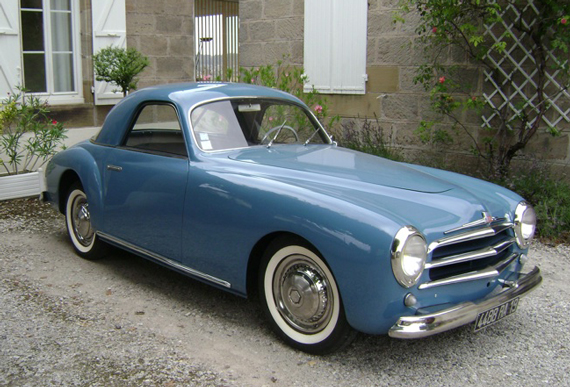
The elegant Simca Sport coupé, introduced in 1948, was produced by the French manufacturer Facel Metalon. Although CEO Jean Daninos was a gifted body stylist himself, the design of this Simca model was identical to a design made by Pinin Farina for a series of special-bodied Fiat 1100.
Structural problems in the French automotive industry
Even before WWII it was clear that the French motorcar industry had problems. The French automakers had lost their leading position in Europe and their total production of passenger cars (199,000) was not only way below that in the US (2,126,000) but also below that of the UK (348,000) and Germany (281,000). The number of cars produced in 1939 was the same as in 1929.
What was the cause of this decline?
1. – There were too many small manufacturers. At the 1938 Paris Motor show, the last to be held before the ‘phony’ war started in September 1939, no less than 32 French makes exhibited. The majority of them had insufficient financial means to invest in new models or modern production methods.
2. – The makers of exclusive premium models such as Bugatti, Delahaye, Delage, Hotchkiss, Panhard, Talbot and Voisin struggled to compete with their British, German and especially American mass produced counterparts such as Cadillac, La Salle or Chrysler.
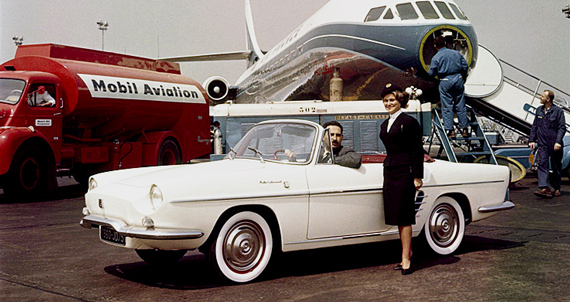
When the state-owned Regie Nationale des Usines Renault wanted a sporting version of their Dauphine to compete with the successful Volkswagen Karmann Ghia, they engaged Pietro Frua and coachbuilder Ghia in Italy to design the prototype. Launched in 1958 as the Renault Floride, the model was later re-baptized to Caravelle (like the famous French jet-airliner on the background). Chausson in Asnieres, which also made coachwork for Renault’s busses, produced the body panels. The factory of Brissonneau and Lotz in Creil (Oise) assembled these models.
Taxes on large and powerful engines
This had also to do with their production volume and was the indirect result of the crippling taxation system that punished the French owners of cars with large and powerful engines. (Note that this tax inequality was before the postwar Plan Pons.) Because of this the French home market for luxury automobiles cars had shrunk dramatically. In addition, the competition with the upmarket models of the French mass producers also increased, leading to a quandary; Why spend 68.000 Francs for a 15 CV Talbot Berline, or 82.000 Francs for a Delahaye with a standard coach body by Chapron, if for 36.000 Francs you could buy a 6 cylinder Citroën 15, or for 41.500 Francs you became the proud owner of a Peugeot Eclipse convertible with its disappearing hard top?
The rationalization of the French car production
After its liberation, in 1944, France was confronted with many problems. Much of its infrastructure and a great number of its production facilities were destroyed by fighting, bombing or the theft their machines by the retreating Germans, and there was a shortage of everything.
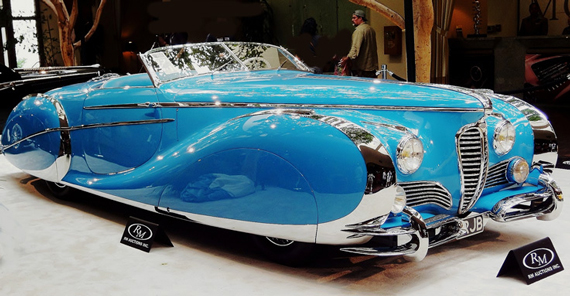
French curves for an English actress. This 1949 Delahaye type 175 Roadster by the famous coachbuilder Saoutchik in Paris, was once owned by the film star and ‘blond sex symbol’ Diana Dors. The body of her impressive Roadster is typical for the ornate style of some French ‘carrossiers’ in those years. RM Auctions sold the Delahaye at their 2010 Monterey Classic cars auction for $3 Million.
Paul-Marie Pons was the Directeur Adjoint of the Division des Industries Mécaniques et Électriques (DIME) at the Ministry de la Production Industriëlle. His boss was the Minister Claude Monet, who was an apostle of government economic planning. What the Plan Pons n 1945 tried to achieve was to improve the competitiveness of the French automobile industry by rationalization of their production.
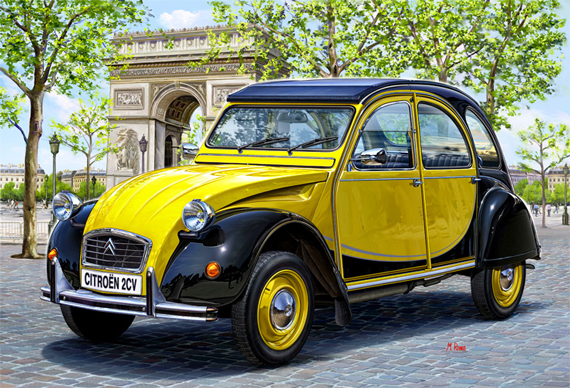
The Plan Pons encouraged the construction of small cars by large manufacturers such as Citroen with their 2CV. Drawing by M. Reinis.
Admittedly the execution of his plan was high-handed and autocratic, favoring the larger French car manufacturers, Berliet, Citroën, Ford France, Panhard, Peugeot, Renault and Simca. Panhard, after much lobbying, was included because they agreed to buy the manufacturing rights of the small AFG car Jean-Albert Gregoire had designed during the war for Aluminium Français. However, Peugeot was forced to collaborate with Hotchkiss, Latil and Saurer for the production of commercial. From the same point of view truckmaker Berliet had to form an association with Isobloc and Rochet-Schneider. And because Louis Renault was suspected of collaboration with the Germans – never proven – Renault became the nationalized Regie Nationale des Usines Renault.
Export or perish
The Plan Pons – perhaps intentionally – completely neglected the interests of the smaller French manufacturers of luxury cars. Their allocation of steel depended on their capacity to export their automobiles. But that was not so easy. Most other European countries had also suffered from the war or the German occupation and their economies did not encourage buying expensive automobiles.
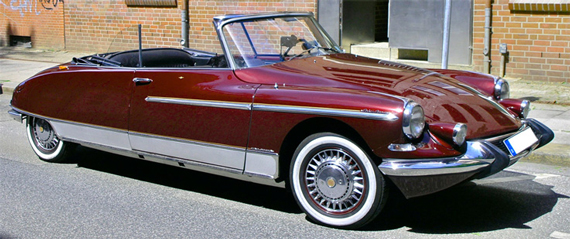
Henri Chapron was one of the last of the great French coachbuilders to survive. Around 1960, after Delahaye, Delage, Hotchkiss, Salmson and Talbot had thrown their towels into the ring, Roger Brioult a French car journalist and editor-in-chief of Revue Technique Automobile convinced Pierre Bercot, then Director of Citroën, that they should supply Chapron with the platforms of their DS for a series of special-bodied cabriolets and coupés. These attractive and luxuriously finished cars were sold by the Citroën dealer network.
Only Switzerland had escaped from these ordeals, but their market was rather small. Besides the chassis and technical specifications of the majority of the French luxury cars stemmed from before the war. This was also the case with most British postwar cars but the industrial situation in Britain was much better than in France. Most of their car factories had been involved in the war effort and many had modern American machines and equipment. The British had also the advantage of a common language for selling their cars to the prosperous North American market.
The situation in Italy
Before Mussolini joined Hitler Germany in WWII, Italy still had a predominantly agricultural-based economy, with demographics more akin to a developing country (high illiteracy, poverty, rapid population growth and a high proportion of adolescents).
In 1938 the production of passenger cars in Italy (59,000) equaled 30% of that in France. The number of automobiles on the road in Italy before the war was around 374,000, in comparison to 1,817,600 in France.
During the early 1950s, the situation of many Italian coachbuilders was nearly as desperate as that of their French colleagues. But the Italians had some advantages.
Experience with small series of monocoque bodies
Traditionally Alfa Romeo, Lancia and even Fiat had always outsourced the manufacture of the bodies for sporting models and convertibles to the specialized coachbuilders. This included their smaller models such as the Lancia Aprilia and the Fiat 1100 and 1500. Many of the Italian carrozzeria therefore had experience with series production and even monocoque constructions.
In contrast most French carrossiers had lived from dressing high priced and high performance chassis from French or foreign premium makes.
The Italian coachbuilders – especially those in the Turin area – were used to working together. If one of them had had too many orders he would engage one of his colleagues to help out. Claude Pourtout, the son of the French carrossier in Marcel Pourtout in Rueil Malmaison, who was a Vice-président of the Fédération Française de la Carrosserie, once told me that he had tried this with his colleagues in Paris but that it did not work there. He only succeeded to get the wide grille that Philippe Charbonneaux designed for Delahaye, to be used by most of them.
Well-trained labor force
Italy had a large number of skilled craftsmen available on the labor market. During the war years many farmhands were trained as mechanics, welders and panel beaters to work in the aviation industry. This contrary to what had happened in France, where many craftsmen had been forced to work as farmhands or slave laborers in German factories.
Important breakthroughs
There were two important events that also helped the Italia carrozzeria to recover their dynamism.
In 1951 a red Cisitalia 202 coupé created by Pinin Farina, after a prototype by aircraft designer Giovanni Savonuzzi, was chosen by the New York Museum of Modern art as part of an exhibition on automotive design. Because Pinin Farina had a good sense of public relations, the resulting publicity confirmed the Italian leadership of motorcar design.
Another important breakthrough was when Alfa Romeo in 1955 decided that Bertone should build the bodies for the Giulietta Sprint coupé. Later the production of the Giulietta Spider was entrusted to Pinin Farina. Both these small sporting vehicles became ambassadors for Italian styling.
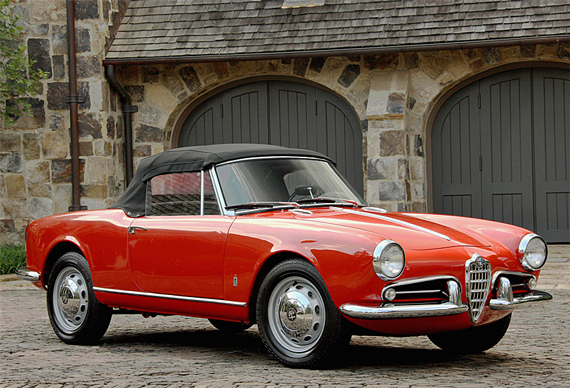
Both Bertone and Pinin Farina benefited from the introduction of the Giulietta, handing to Italian coachbuilders the rights to construct the bodies for both the Sprint and Spider.
Turin and Milan become the fashion centers of the motor industry
It is hardly surprising that a great number of non-Italian car manufacturers crossed the Alps to engage the services of Bertone, Pininfarina, Ghia, Touring and a few smaller carrozzeria. Some of them also hired Italian designers such as Giovanni Michelotti and Giorgetto Giugiaro to shape their bread and butter automobiles and their sporting machines. The client list for Italian coachwork style comprised: Aston Martin, British Motor Corporation (Austin, MG, Morris, Wolseley and Riley), Bristol, DAF, GM, Peugeot, Triumph and Volkswagen.
Between 1950 -1960, due to devaluation, the value of the Italian lira became very favorable for those paying in US Dollars. For this reason, and the fact that the Italian craftsmen were fast workers, many leading American automakers send chassis over to Turin or Milan to have their concept cars build there.
As success breeds success, the 1950 became the start of a boom for the Italian carrozzeria. It is a great pity that in recent years most of them have completely disappeared or are just struggling to survive. But that is another (hist)story.

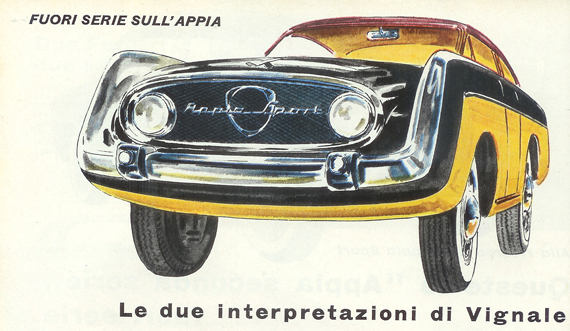
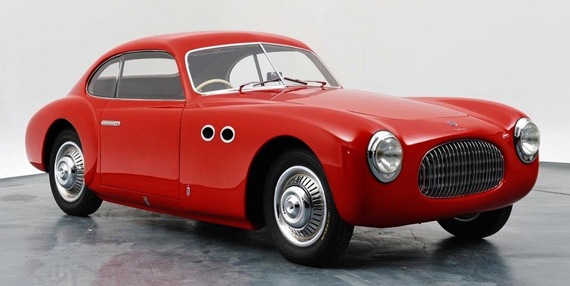
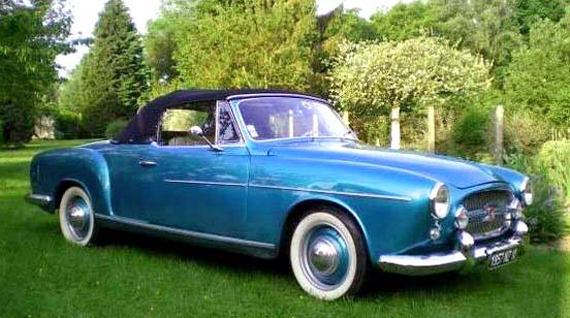
Nicely done!
~ Wonderfully told, in depth article. Thanks for making the story easy to comprehend.
quite interesting !
Judging from this article–and from the results on the road–the major difference between the Italian and French designers was talent. The esthetics of the large French cars, while exceptional, are no match in staying-power for their Italian counterparts. And those of the smaller French sports cars are also overshadowed by the classical simplicity of Italian designs for similarly sized cars. An interesting comparison might have been the 2CV vs. the Fiat 500; both exhibited engineering sophistication in a small mass-produced car, but the Fiat’s design was more in keeping with the aspirations of an urban class moving up from motorbikes. Was it that, on balance, the Italians designed for beauty, the French for function?
Wonderful story by Paul-Berk on a subject that warms my heart, Would never forget the so pretty SIMCA Huit of my youth, Roger Barlow had shipment that
arrived final day of Dec 1950 and had to rush delivery of car as ordered by my
late wife, Dorothy Deen.He kept workers on it for New Year Day delivery,
This model popular in Hollywood then, another sold to famous photographer Jerry Chesebrough of Road & Track, Barlow himself had gone to Tampa, Florida
dealer operated by Roy Evans,(he was better known as operating the pre-war
Austin Bantam factory in America.) Roger drove the car back to Southern Calif.
I do feel the orig design was actually that of Stablimenti Farina, which was then
a separate organization.
Fast forward to 1995 I went to auction to bid on a one owner car(Willet Brown)
but was quickly outbid by friend from Cambria who shared the passion,Damn,!
Jim sitz
lazydazy534@q.com
With Greeting,
Kindly I want to contact Mr. Mike Hyatt. please tell him .
Thanks in advance.